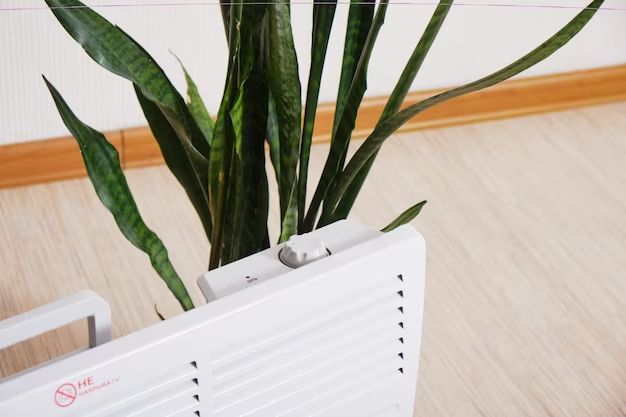Many plant owners wonder if using a space heater is beneficial or harmful for their houseplants. Space heaters can help maintain warm temperatures that some tropical plants prefer, but they can also dry out the air and potentially scorch plants if placed too close. Knowing the pros and cons of using space heaters around indoor plants can help you make the right choice for your situation.
Page Contents
Can space heaters be used for plants?
Yes, space heaters can be used to provide warmth for plants indoors. Some key benefits of using a space heater for plants include:
- Maintaining optimal temperatures – Many popular houseplants are tropical or subtropical plants that prefer consistent warm temperatures between 65-80°F. Space heaters help maintain these temperatures when indoor conditions are too cool.
- Protecting from cold drafts – Positioning a space heater nearby can shield plants from cold drafts from windows, doors, or air conditioning vents that can shock them.
- Boosting growth – Warmth from space heaters encourages faster plant growth for many species by accelerating their metabolic processes.
- Increasing humidity – Some space heaters are designed to simultaneously heat and humidify the surrounding air, which benefits many houseplants.
- Providing heat during colder months – Running a space heater indoors provides a source of warmth when outdoor temperatures drop too low to be suitable for houseplants.
So in many situations, using a space heater near indoor plants can provide benefits and create better growing conditions. However, there are also some potential downsides to consider.
Potential risks of using space heaters for plants
While space heaters can be helpful for plants, there are also some hazards to keep in mind:
- Dry air – Space heaters are notorious for drying out the surrounding air, which plants don’t like. This dryness can damage leaves or cause stress.
- Temperature fluctuations – If the heater turns off at night or temperatures vary widely, it exposes plants to temperature shifts they don’t like.
- Risk of scorching – Putting plants too close can overheat their leaves and actually scorch or kill them.
- Fire hazards – Space heaters pose fire risks, especially around flammable materials like dry soil and leaves.
- Higher energy bills – Running electric space heaters routinely will increase your electricity usage and costs.
- Limited heated area – The heat doesn’t penetrate far from the heater, so plants out of the direct warming zone won’t benefit.
So you do need to exercise some caution in using space heaters for your plants. Follow some tips to maximize the benefits while minimizing any risks.
Tips for using space heaters for indoor plants
Here are some best practices for safely using space heaters to warm your houseplants:
- Select a newer, high-quality heater – Models with safety features like automatic shut-off prevent potential risks.
- Opt for oil-filled or ceramic heaters – These maintain more stable temperatures without drying the air as much.
- Use a humidifier – Adding a humidifier combats any drying effects from the heater.
- Keep plants 3-4 feet away – This prevents scorching while still providing warmth.
- Move plants closer only briefly – Occasionally place plants right beside the heater for 15-30 minutes to provide a burst of warmth.
- Maintain day/night temperature changes – Don’t run the heater constantly or plants won’t get the temperature drop they need at night.
- Monitor conditions closely – Check soil moisture, humidity, and plant appearance so adjustments can be made.
- Provide good air circulation – Use fans to circulate the warm air and reinforce sturdy plants so they don’t bend towards the heat source.
- Pay attention to running costs – Only use the space heater as needed to conserve energy.
Following these guidelines will allow you to create an environment where your plants can thrive under the gentle heat from a space heater.
Best plants for space heaters
Many common houseplants appreciate the extra warmth provided by space heaters. Some top options include:
| Plant | Preferred Temperature Range |
|---|---|
| African Violet | 65-75°F |
| Peace Lily | 65-85°F |
| Chinese Evergreen | 60-75°F |
| Pothos | 65-85°F |
| Croton | 65-85°F |
| Bromeliads | 65-85°F |
| Palms | 60-75°F |
| Ficus | 65-75°F |
| Dracaena | 65-75°F |
| Philodendron | 65-85°F |
These tropical plant species tend to thrive in the warmer conditions that a space heater provides indoors. Just be sure to maintain proper humidity levels as well.
Plants that should avoid space heaters
While many plants benefit from the additional warmth of space heaters, some may suffer in hotter, drier conditions. Plants that prefer cooler temperatures and higher humidity may decline near a constantly-running space heater. Some plants to keep further away from space heaters include:
- Orchids
- Ferns
- Calatheas
- Prayer plants
- Bonsai trees
- Cacti and succulents
- Gerbera daisies
- Gardenias
- Impatiens
- Begonias
Monitor these types of plants closely if using a space heater nearby, and make adjustments to distance or humidity as needed. Keeping them 3-4 feet back is best. Also avoid hot, dry airflow directly on their leaves.
Conclusion
Space heaters can be a helpful tool for providing warmth for indoor houseplants that prefer hotter conditions. Many tropical plants will benefit from the ambient heat a space heater provides during colder months or in cooler indoor environments. However, the potential for dry air and scorching exists if space heaters aren’t used carefully around plants. Position plants an adequate distance away, provide plenty of humidity, and monitor conditions to balance safety and optimal temperatures. With some extra care, space heaters can be great for growing thriving indoor plants all year round.
